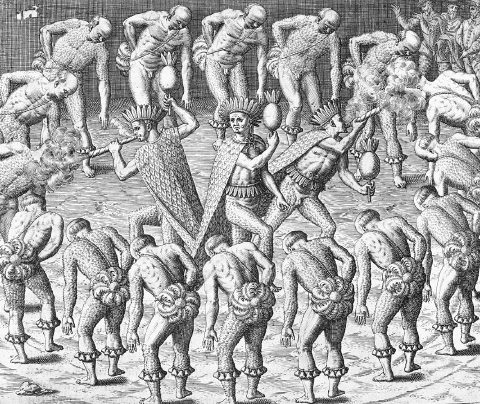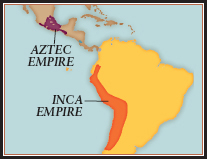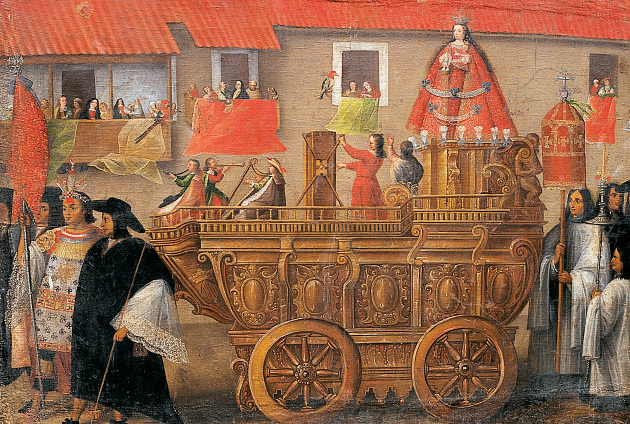Global Perspectives
Music and Early European Colonialism
In introducing the Renaissance, on page 60, we echoed the words of a historian who saw in it “the discovery of the world and of man.” But we have not yet said much about the world part of this formulation.
The period from 1480 to 1620 marks the first great phase of European expansion into other parts of the world. The most famous European voyages of exploration, by Bartolomeu Dias, Vasco da Gama, Columbus, and Magellan, were followed by countless others. Trade routes to Africa and the New World were quickly established — so quickly that from 1492 on, only one year passed without European journeys to the Americas.
The voyages of exploration were more than sheer adventurism or innocent trading ventures. They were also expeditions of military conquest and territorial expansion. They marked the beginning of aggressive European colonization of large portions of the rest of the globe that would last almost five hundred years, well into the 1900s, and would profoundly shape the modern world.
Cultural Conquest and Music
The European attempt to conquer was cultural as well as military. In the immediate wake of European soldiers and conquistadors came missionaries aiming to convert the native peoples to Christian beliefs — whether by persuasion or harsher measures. Wherever they went, soldiers, missionaries, and merchants reported back to a fascinated Europe on the novelties they found.

These reports — some precise and evidently accurate, others very fanciful — often made room for descriptions of music. They inform us of musical traditions that today are at least much changed and, in many cases, simply extinct. From the 1590s comes a description of African music in the Congo. (For discussion of West African drumming, see page 397.) English mariners report on Native North American song and dance (see page 59), and Dutch explorers tell about the elaborate gong orchestras, or gamelans, still played today in Indonesia (see page 199). The Jesuit Father Matteo Ricci, the first European allowed to reside in the imperial capital of Beijing, was scandalized by Chinese opera, “a curse,” in his view, “more prone to vice” than any other activity (for more on Chinese opera, see page 297).
Music of the Aztecs and Incas

The Aztec and Inca empires were the greatest civilizations Europeans came upon in the New World. They amazed their conquerors with their cultural achievements and complexity, their riches, and their astonishing capitals: Tenochtitlán, in the middle of a Mexican lake that has long since disappeared under Mexico City, and Cuzco, built so high up in the Andes that the Spaniards established Lima, a low-
Since they had elaborate religious institutions of their own, the Mexicans and Andeans presented the European missionaries with their first great challenges for religious conversion in the New World. The missionaries systematically studied Aztec and Inca culture to determine how best to achieve their goal, and they taught the natives all the elements of a Christian life as they saw it. Prominent among their studies was native music; central to their teachings was European music.
Inevitably, the two musics were thrust into confrontation. A Mexican church council of the sixteenth century ruled that native musicians “shall sing polyphonic music only when their singing conforms to standards we consider acceptable . . . and they shall not be permitted to sing songs that remind people of their old idolatrous customs.” A church council at Lima tried to abolish altogether singing and dancing at native harvest festivals. Meanwhile, the missionaries encouraged native song and dance in Christian festivals, hoping that they would hasten the Andeans’ acceptance of the new, foreign religion.
These efforts could not succeed completely. We know that native singers preserved their traditional songs, often singing them secretly, away from the eyes and ears of the authorities. At the same time they easily learned and adopted the European music the missionaries pressed on them. By the mid-
Inca Processional Music
The song “Hanaq pachap kusikuynin” is a fascinating case of the musical merging of two cultures. Published in 1631 by a Franciscan friar named Bocanegra, it is the first piece of elaborate music to be published anywhere in the New World. The words of the song are in the native Andean language Quechua (ket-chwa). Was it the work of Bocanegra himself, or one of the new Indian composers? We cannot be sure.

The song is a hymn to the Virgin Mary. Bocanegra says that it was sung during religious processions honoring her, like the one pictured to the right. Imagine the scene in 1630 in front of the still unfinished cathedral of Cuzco, built on the sturdy foundations of an Inca palace: Native singers march in procession across the plaza, wearing the traditional garb still permitted for Christian festivals, singing Quechua words set to European-
As they enter the church, they regroup as a choir for services including Gregorian chant, now with Latin words — perhaps “Ave maris stella,” the widely used hymn to the Virgin that we have already studied. Next comes newly composed polyphonic music. Such are the cultural mixes that arise in colonial situations.
Our performance of “Hanaq pachap kusikuynin” is tamer than this — no instruments are used. The music is simple but moving. It sets the phrases of the Quechua text one by one, in the straightforward homophonic texture we have heard in Dufay’s harmonization of “Ave maris stella” and Palestrina’s Pope Marcellus Mass (see pages 61 and 70).
LISTEN
“Hanaq pachap kusikuynin”
| Hanaq pachap kusikuynin Waranqakta much’asqayki |
Bliss of heaven, A thousand times I adore you. |
| Yupay ruru puquq mallki Runakunap suyakuynin Kallpannaqpa q’imikuynin Waqyasqayta |
Tree of myriad fruits, Hope of peoples, Pillar of the weak: Hear my cry. |
| (one more stanza) |